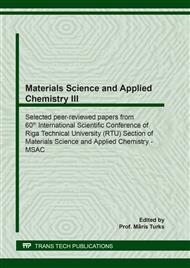[1]
N.Wu et al., In Photo-Polymerization Efficiency of Self-Etch Dentaladhesives Composed of Amphorquinone Ortrimethylbenzoyl-Diphenyl-Phosphine Oxide, Int. J.Adhes. Adhes. 45 (2013) 53-58.
Google Scholar
[2]
S.Murdan, Drug Delivery to the Nail Following Topical Application, Int. J. Pharm. 236 (2002) 1-26.
Google Scholar
[3]
Z. Grigale-Sorocina, I. Birks, Hectorite and Bentonite Effect on Water-Based Polymer Coating Rheology, C. R. Chimie. 22 (2019) 169-174.
DOI: 10.1016/j.crci.2018.11.011
Google Scholar
[4]
S.Murdan, at al., To what Extent Do In Vitro Tests Correctly Predict the In Vivo Residence of Nail Lacquers on the Nail Plate? J. Drug Deliv. Sci. Tec. 25 (2015) 23-28.
DOI: 10.1016/j.jddst.2014.11.002
Google Scholar
[5]
Z.Grigale-Sorocina, M.Kalnins, Methods to Evaluate the Adhesion Behavior for UV-Activated Urethane Acrylate Composite Coatings for Short Term Applications, Proceed. Mater. Sci. Appl. Chem., MSAC, 2016, 63-67.
DOI: 10.5755/j01.ms.22.1.7442
Google Scholar
[6]
L.V. Kerai et al., UV Curable Gel Formulations: Potential Drug Carriers for the Topical Treatment of Nail Diseases, Int. J. Pharm. 492 (2015) 177-190.
DOI: 10.1016/j.ijpharm.2015.07.020
Google Scholar
[7]
S. Naumann et al., Controlled Nail Delivery of a Novel Lipophilic Antifungal Agent Using Various Modern Drug Carrier Systems As Well As In Vitro and Ex Vivo Model Systems, J. Controlled Release. 180 (2014) 60-70.
DOI: 10.1016/j.jconrel.2014.02.013
Google Scholar
[8]
P.P. Shandbag, U.Jani, Drug Delivery Through Nails: Present and Future, J. Drug Deliv. Sci. Tec. 3 (2017) 252-263.
Google Scholar
[9]
P.Chouhan, T.R. Saini, Hydration of Nail Plate: A Novel Screening Model for Transungual Drug Permeation Enhancers, Int. J. Pharm. 436 (2012) 179-182.
DOI: 10.1016/j.ijpharm.2012.06.020
Google Scholar
[10]
M. Oguri et al., Effects of Functional Monomers and Photo-Initiators on the Degree of Conversion of a Dental Adhesive, Acta Biomater. 8 (2012) 1928-1934.
DOI: 10.1016/j.actbio.2012.01.013
Google Scholar
[11]
Y. Liu, Y. Wang, Effect of Proanthocyanidins and Photo-Initiators on Photo-Polymerization of a Dental Adhesive, J. Dent. 41 (2013) 71-79.
DOI: 10.1016/j.jdent.2012.10.006
Google Scholar
[12]
I. Sideridou et al., Effect of Chemical Structure on Degree of Conversion in Light-Cured Dimethacrylate-Based Dental Resins, Biomaterials 23 (2002) 1819-1829.
DOI: 10.1016/s0142-9612(01)00308-8
Google Scholar


